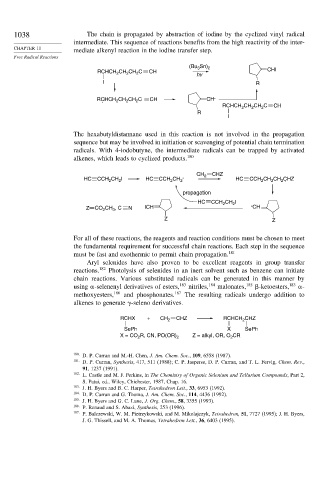Page 1054 - Advanced Organic Chemistry Part A - Structure and Mechanisms, 5th ed (2007) - Carey _ Sundberg
P. 1054
1038 The chain is propagated by abstraction of iodine by the cyclized vinyl radical
intermediate. This sequence of reactions benefits from the high reactivity of the inter-
CHAPTER 11
mediate alkenyl reaction in the iodine transfer step.
Free Radical Reactions
Sn)
(Bu 3 2
CH CH C CH CHI
RCHCH 2 2 2 hv
I R
.
RCHCH CH CH C CH CH
.
2
2
2
CH CH C CH
RCHCH 2 2 2
R
I
The hexabutyldistannane used in this reaction is not involved in the propagation
sequence but may be involved in initiation or scavenging of potential chain termination
radicals. With 4-iodobutyne, the intermediate radicals can be trapped by activated
alkenes, which leads to cyclized products. 180
HC CCH CH I HC CCH CH 2 . CH 2 CHZ HC CCH CH CH CHZ
2 .
2
2
2
2
2
propagation
HC CCH CH I .
2
2
Z CO CH , C N ICH CH
2
3
Z Z
For all of these reactions, the reagents and reaction conditions must be chosen to meet
the fundamental requirement for successful chain reactions. Each step in the sequence
must be fast and exothermic to permit chain propagation. 181
Aryl selenides have also proven to be excellent reagents in group transfer
reactions. 182 Photolysis of selenides in an inert solvent such as benzene can initiate
chain reactions. Various substituted radicals can be generated in this manner by
using -selenenyl derivatives of esters, 183 nitriles, 184 malonates, 185 -ketoesters, 183 -
methoxyesters, 186 and phosphonates. 187 The resulting radicals undergo addition to
alkenes to generate -seleno derivatives.
RCHX + CH 2 CHZ RCHCH CHZ
2
SePh X SePh
X = CO R, CN, PO(OR) 2 Z = alkyl, OR, O CR
2
2
180 D. P. Curran and M.-H. Chen, J. Am. Chem. Soc., 109, 6558 (1987).
181 D. P. Curran, Synthesis, 417, 511 (1988); C. P. Jasperse, D. P. Curran, and T. L. Fervig, Chem. Rev.,
91, 1237 (1991).
182
L. Castle and M. J. Perkins, in The Chemistry of Organic Selenium and Tellurium Compounds, Part 2,
S. Patai, ed., Wiley, Chichester, 1987, Chap. 16.
183 J. H. Byers and B. C. Harper, Tetrahedron Lett., 33, 6953 (1992).
184
D. P. Curran and G. Thoma, J. Am. Chem. Soc., 114, 4436 (1992).
185 J. H. Byers and G. C. Lane, J. Org. Chem., 58, 3355 (1993).
186 P. Renaud and S. Abazi, Synthesis, 253 (1996).
187
P. Balczewski, W. M. Pietrzykowski, and M. Mikolajczyk, Tetrahedron, 51, 7727 (1995); J. H. Byers,
J. G. Thissell, and M. A. Thomas, Tetrahedron Lett., 36, 6403 (1995).

